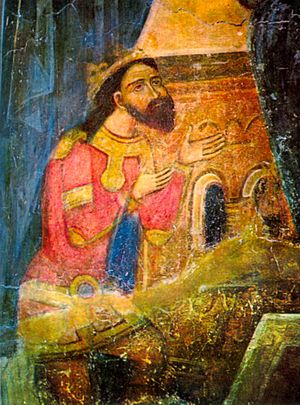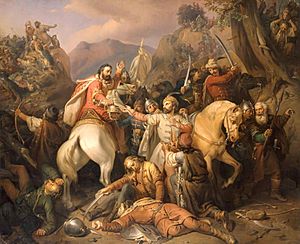Basarab I of Wallachia facts for kids
Quick facts for kids Basarab I the Founder |
|
|---|---|

Basarab I (fresco in Argeș)
|
|
| Voivode of Wallachia from c. 1344 with Nicolae Alexandru |
|
| Reign | c. 1310/between 1304 and 1324 – 1351/1352 |
| Predecessor | Radu Negru or Thocomerius |
| Successor | Nicholas Alexander of Wallachia |
| Died | 1351 or 1352 |
| Spouse | Doamna Marghita (Margarete) |
| Issue | Nicholas Alexander of Wallachia Theodora of Wallachia |
| Dynasty | Basarab |
| Father | Radu Negru, or Thocomerius |
| Religion | Christian |
Basarab I (Romanian: [basaˈrab]), also known as Basarab the Founder (Romanian: Basarab Întemeietorul), was a very important leader in the 14th century. He was the first independent ruler of Wallachia, a historical region in what is now Romania. We don't know many exact details about his life.
Basarab's name comes from Turkic languages, but old writings from the 1300s all say he was a Vlach (Romanian). He likely became ruler around 1310, taking over from his father, Thocomerius. Some historians think he might have taken power between 1304 and 1324 from the legendary founder of Wallachia, Radu Negru.
The first official paper mentioning Basarab is from July 26, 1324. It shows he was a voivode (a type of duke or military leader) under Charles I of Hungary. However, Basarab soon became "disloyal" to the Hungarian king in 1325. He took control of the Banate of Severin and attacked southern parts of the Kingdom of Hungary.
Basarab helped Michael Shishman of Bulgaria attack Serbia. But their combined armies lost the Battle of Velbazhd on July 28, 1330. Soon after, Charles I of Hungary invaded Wallachia. Basarab's forces surprised and almost completely defeated the Hungarian army in the Battle of Posada. This battle happened between November 9 and 12, 1330.
The Battle of Posada was a huge victory for Basarab. It ended Hungary's control over Wallachia. This led to the creation of the first independent Romanian principality. Basarab's family ruled Wallachia for at least 200 years. The region of Bessarabia, located between the Dniester and Prut rivers, was named after the Basarab dynasty.
Contents
Who Was Basarab?
Basarab was the son of Thocomerius. This is known from a document written by Charles I of Hungary in 1332. We don't know much about Thocomerius's background. Some historians believe he was a powerful local leader.
Basarab's name has Turkic roots. The first part, bas-, means "press, rule, govern." The second part, aba or oba, means "father" or "elder." This is similar to names used by the Cumans, a Turkic people. This might suggest Basarab had Cuman ancestors, but there's no strong proof. However, several royal documents from the 1300s clearly call Basarab a Vlach (Romanian). For example, Charles I of Hungary called him "Basarab, our disloyal Vlach" in 1332.
Some old letters from Pope John XXII in 1327 called Basarab a "devout Catholic prince." This has led some historians to think he might have been Catholic. However, most other sources say Basarab belonged to the Eastern Orthodox Church. For instance, a book called the Illuminated Chronicle from the 1350s called him a "perfidious schismatic," which means someone who has broken away from the main church.
Basarab's Time as Ruler
We don't know exactly how Basarab became ruler. Old Romanian stories say that Radu Negru founded Wallachia. Some stories even suggest that Basarab's family was a powerful noble family in Oltenia who accepted Radu Negru's rule. Other historians believe Basarab simply took over from his father, Thocomerius, around 1310.
Working with Charles I
Basarab was first mentioned in a royal document from Charles I of Hungary on July 26, 1324. This document called him "our voivode of Wallachia." This means Charles I saw Basarab as a loyal helper at that time. Historians think Basarab agreed to be loyal after Charles I took back control of the Banate of Severin in 1321. In return, Basarab was allowed to keep control of Severin Fort.
Gaining Independence
By June 1325, Basarab was no longer loyal to the Hungarian king. A document from that time calls him "disloyal to the Holy Crown of Hungary." Another document from 1329 listed Basarab as an enemy. It said he, along with Bulgarians, Serbs, and Tatars, was attacking areas around Mehadia. Basarab seemed to control the Banate of Severin completely between 1324 and 1330.
In 1330, Michael Shishman of Bulgaria, the Tsar of Bulgaria, attacked Serbia. Basarab led his own army to help Shishman. They also had soldiers from the Yas and "black Tatar" groups. However, the Serbs defeated their combined army at the Battle of Velbazhd on July 28, 1330. Shishman was killed while trying to escape.
After this defeat, Charles I of Hungary decided to take back control of Wallachia. He invaded Oltenia and captured Severin Fort in September 1330. Basarab offered to pay a large amount of silver and a yearly tribute to the king. He also promised to send one of his sons to the royal court in Visegrád.
But Charles I refused Basarab's offer. He said Basarab was "the shepherd of my sheep, and I will drag him by his beard from his lair." Charles continued his attack, but his soldiers suffered from hunger as they marched towards Curtea de Argeș. Charles had to agree to a ceasefire, and his army began to retreat.
On November 9, the Wallachians ambushed the king and his soldiers. This happened in a narrow mountain pass in the Southern Carpathians. Basarab's soldiers stood on the cliffs above the valley. They shot arrows and threw rocks down on the Hungarian army. The battle lasted until November 12. The Hungarian army was almost completely destroyed, and King Charles barely escaped. This victory for Basarab at the Battle of Posada was a major event.
Wallachia Becomes Independent
After the Battle of Posada, Basarab's capital, Curtea de Argeș, was damaged. He moved his main base to Câmpulung. Basarab's victory allowed Wallachia to act more freely in its relations with other countries. He supported his son-in-law, Ivan Alexander of Bulgaria, who became the Bulgarian king in February 1331. With Basarab's help, Ivan Alexander also fought successfully against the Byzantine Empire in 1331 and 1332.
Around 1340, Basarab began rebuilding Curtea de Argeș. New defenses and a new palace were built. The construction of the Princely Church of Saint Nicholas in Curtea de Argeș also started during Basarab's rule. However, it was finished after he died. Basarab likely made his son, Nicholas Alexander of Wallachia, a co-ruler around 1344.
Basarab died in 1351 or 1352.
Basarab's Family
An old religious artwork from Câmpulung mentions "Io Basarab voivode and his wife, Marghita." Historians generally believe Basarab's wife was named Marghita (or Margarete).
Basarab's daughter, Theodora of Wallachia, was married to Ivan Alexander of Bulgaria. This is known from a letter written by Stephen Dušan, who became King of Serbia. Basarab likely arranged this marriage around 1323 to make his alliance with Bulgaria stronger. Theodora had children with Ivan Alexander. However, Ivan Alexander later left her and married another woman in the 1350s. Basarab's son and successor, Nicholas Alexander, later ended Wallachia's alliance with Bulgaria.
Basarab's Lasting Impact
Basarab's victory at the Battle of Posada changed Wallachia's history forever. This victory officially made Wallachia independent from the Hungarian crown. Historians call Wallachia the "first independent Romanian principality." Even though Hungarian kings still tried to control Wallachia, Basarab and the rulers who came after him only gave in for short periods in the 1300s.
Basarab's family ruled Wallachia for at least 200 years. Famous descendants include Mircea the Old and Vlad Dracula.
From the mid-1300s, people in Bulgaria, Hungary, Moldavia, and Serbia started calling Wallachia "Basarab." Later, the southern part of the land between the Dniester and Prut rivers was named Basarabia. When the Russian Empire took over this region in 1812, it was officially renamed Bessarabia. Today, this region is part of the Republic of Moldova.
See also
- Foundation of Wallachia
- Cumania
- In Spanish: Basarab I de Valaquia para niños
Sources
Primary sources
- The Hungarian Illuminated Chronicle: Chronica de Gestis Hungarorum (Edited by Dezső Dercsényi) (1970). Corvina, Taplinger Publishing. ISBN: 0-8008-4015-1.



